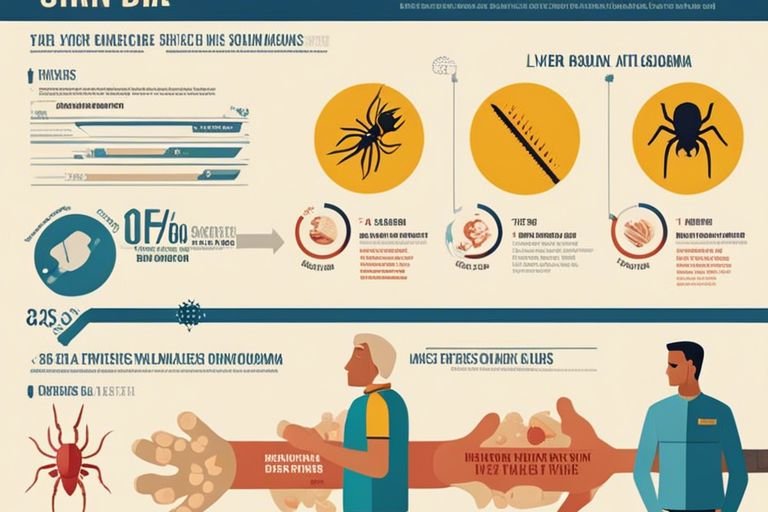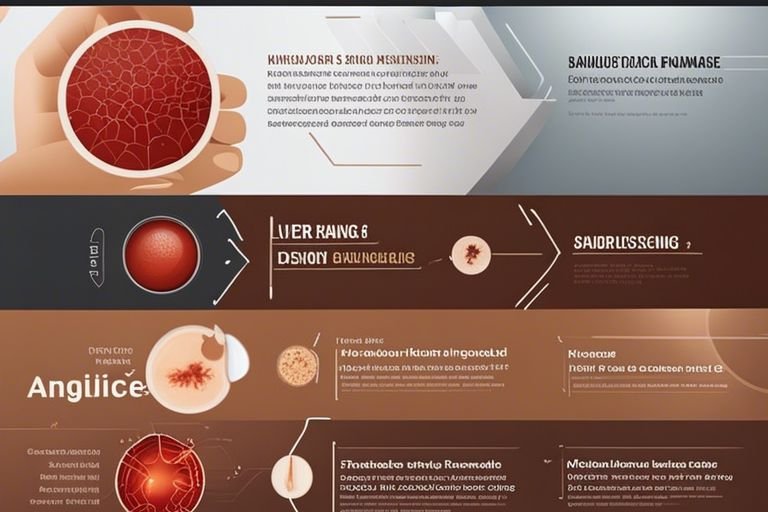Most people may not realize that the health of our liver can manifest through various skin issues. In this comprehensive guide, we will examine into the different skin problems that may indicate liver damage, such as jaundice, spider angiomas, and itching. By understanding these warning signs, you can take proactive steps to monitor your liver health and seek medical attention if necessary.

Key Takeaways:
- Pay attention to skin changes: Skin issues such as jaundice (yellowing of the skin), spider angiomas (spider veins), and palmar erythema (red palms) can indicate liver damage.
- Look for itching and rash: Persistent itching, eczema, or other rashes on the skin can be a sign of liver problems and should be evaluated by a healthcare professional.
- Consult a doctor: If you notice any unusual skin symptoms or changes that could be linked to liver damage, it is important to seek medical advice for proper diagnosis and treatment.
Understanding the Connection Between Liver Damage and Skin Issues
A healthy liver plays a crucial role in maintaining clear and vibrant skin. Liver damage can manifest itself through various skin issues, indicating underlying health problems that need to be addressed. Understanding the connection between liver health and skin problems can help in early detection and prompt treatment.
Types of Skin Issues Linked to Liver Damage
A variety of skin conditions can be linked to liver damage, such as jaundice, itching, spider angiomas, palmar erythema, and ecchymosis. These skin issues are often the first visual cues that indicate possible liver dysfunction.
| Jaundice | Yellowing of the skin and eyes |
| Itching | Generalized itching all over the body |
| Spider Angiomas | Reddish spider-like blood vessels on the skin |
| Palmar Erythema | Red palms with a distinct reddish hue |
| Ecchymosis | Unexplained bruising or purple patches on the skin |
- Recognizing these skin issues can prompt further investigation into potential liver damage.
Factors Contributing to Liver Damage Causing Skin Problems
Various factors can contribute to liver damage leading to skin problems. Alcohol abuse, hepatitis infections, fatty liver disease, drug toxicity, and certain medications are common culprits that affect liver health and manifest on the skin.
- Recognizing these factors and addressing them promptly is crucial in preventing further liver damage.
Problems like alcohol abuse and hepatitis infections can strain the liver, impacting its ability to function properly. This can lead to a buildup of toxins in the body and result in various skin issues that serve as warning signs of underlying liver damage.
- Recognizing these warning signs early on can help in timely intervention and treatment to prevent further complications.
Issues related to liver damage and skin problems should not be ignored, as they can indicate more serious underlying health issues. Regular monitoring of skin health and paying attention to any changes can help in early detection and treatment of liver-related conditions.
Identifying Early Warning Signs of Liver Damage Through Skin Issues
Now, one of the ways to detect liver damage early on is through skin issues. By keeping an eye on any changes in your skin, you can potentially catch liver damage in its early stages. It’s important to educate yourself on the various signs to look out for. For more detailed information, you can refer to The Liver Book: A Comprehensive Guide to Diagnosis ….
Common Skin Symptoms of Liver Damage
One common skin symptom of liver damage is jaundice, where the skin and eyes appear yellowish. Other signs include itching, spider angiomas (small clusters of blood vessels near the surface of the skin), and palmar erythema (reddening of the palms).
Tips for Recognizing Subtle Skin Changes
For tips on recognizing subtle skin changes that may indicate liver damage, pay attention to any unexplained bruising or changes in skin color. Keep an eye out for any new moles or growths on the skin that weren’t there before. Any sudden increase in skin sensitivity or dryness should also be noted.
- Monitor your skin for any unexpected changes regularly.
- Consult a dermatologist if you notice anything unusual or persistent.
The health of your liver can often be seen through changes in your skin. It’s imperative to be proactive in monitoring and recognizing these signs early on. By staying informed and vigilant, you can take steps to address any potential liver damage and seek appropriate medical advice promptly.
A Step-by-Step Guide to Self-Diagnosis and Prevention
| How to Monitor Your Skin for Liver Damage Indicators | Lifestyle Changes to Reduce the Risk of Liver Damage |
| An easy way to monitor your skin for potential liver damage indicators is to regularly check for signs such as yellowing of the skin or eyes (jaundice), itchy skin, dark urine, or unusually pale or dark stools. | The liver is a vital organ that plays a crucial role in detoxifying the body. To reduce the risk of liver damage, it is important to adopt a healthy lifestyle, including maintaining a balanced diet, exercising regularly, limiting alcohol consumption, avoiding exposure to harmful chemicals, and staying hydrated. |
Damage: Lifestyle choices can have a significant impact on liver health. Maintaining a healthy weight, avoiding excessive alcohol consumption, and practicing safe sex to prevent hepatitis infections are all important steps in reducing the risk of liver damage.

Weighing the Pros and Cons of Medical Intervention
All medical decisions come with their own set of pros and cons, and when it comes to detecting liver damage from skin issues, it’s necessary to consider them carefully. Below is a breakdown of the benefits and potential drawbacks of medical intervention in such cases:
| Pros | Cons |
| Early detection can lead to timely treatment and better outcomes. | Potential side effects from treatments and medications. |
| Medical professionals can provide expert guidance and support. | Financial burden of medical procedures and ongoing treatment. |
| Access to advanced diagnostic tools and technologies for accurate diagnosis. | Emotional stress and anxiety related to medical procedures. |
| Improved quality of life with proper management of liver damage. | Possible complications from invasive procedures. |
Benefits of Early Detection and Treatment
Medical intervention in detecting liver damage from skin issues can offer the benefit of early detection and treatment. This can lead to better outcomes and improved quality of life for individuals at risk. To learn more about liver damage and disease, check out What You Need to Know About Liver Damage and Disease.
Potential Drawbacks and Risks of Medical Intervention
Clearly, along with the benefits, there are potential drawbacks and risks associated with medical intervention in cases of liver damage and skin issues. It is crucial to weigh these factors carefully before making any decisions. Potential risks may include side effects from treatments, financial burdens, and emotional stress related to the procedures.
While medical intervention can play a crucial role in detecting and managing liver damage from skin issues, it’s necessary to consider all factors before moving forward with any treatment plan. Consulting with healthcare professionals and discussing the pros and cons can help individuals make informed decisions about their health.
To wrap up
Ultimately, being aware of potential skin issues that could indicate liver damage is crucial for early detection and treatment. By recognizing subtle changes in your skin, seeking medical advice, and maintaining a healthy lifestyle, you can protect your liver health and overall well-being. Keep in mind, consult with a healthcare professional for proper diagnosis and guidance on managing any liver-related concerns.
FAQ
Q: What are some common skin issues that may indicate liver damage?
A: Some common skin issues that may indicate liver damage include jaundice (yellowing of the skin and eyes), itchy skin, spider veins, purpura (purple or red discoloration of the skin), and dry and itchy skin.
Q: How can skin issues help in detecting liver damage?
A: Skin issues can help in detecting liver damage because the liver plays a key role in detoxifying the body. When the liver is damaged, it may not be able to effectively remove toxins from the body, leading to various skin issues as a result.
Q: What should I do if I suspect liver damage based on skin issues?
A: If you suspect liver damage based on skin issues, it is important to consult a healthcare provider for further evaluation and testing. They may recommend blood tests, imaging studies, or a liver biopsy to assess the condition of your liver and determine the appropriate course of treatment.
